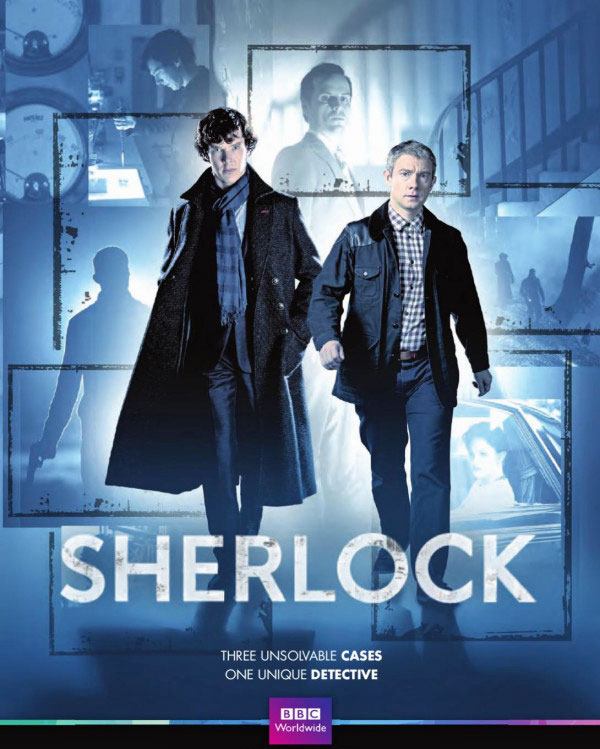The third adaptation of Doyle’s story, A Study in Scarlet (1887) is the first episode of the first season of the BBC series Sherlock in 2010 titled, A Study in Pink. Mark Gatiss and Steven Moffat are the screenwriters for the series. Steven Moffat is well known for his reboot of the Doctor Who series on the BBC. They cast Benedict Cumberbatch to play Sherlock Holmes whom at the time was a relatively unknown British theatre and film actor. They have chosen to set the characters and stories in modern day London with twenty-first century technology. Their characters and stories exist without Doyle’s Canon. Figure 13 shows is the second season series poster.

Figure 13: BBC Sherlock Season 1 poster Source credit: https://www.arthur-conan-doyle.com/index.php?title=File:Sherlock-BBC-poster-2.jpg
This poster establishes the new series with Sherlock wearing a black modern coat and blue scarf. Since the series is set in modern day London they have removed images of the magnifying glass and deerstalker hat. Benedict Cumberbatch and Martin Freeman are clean-shaven unlike the previous Holmes and Watsons’. The squares are compartmentalized showing Moriarty, Irene Adler or “The Woman, Sherlock working in a lab, and a man with a gun. The image of Holmes working in the lab hearkens back to Doyle’s original story and pictures from Gillette’s Sherlock Holmes (1916). The title text below the actors puts emphasis on Sherlock. The bylines of “Three unsolvable cases, one unique detective” allude to Sherlock as an exceptional character. Sabine Vanacker in the book, Sherlock Holmes and Conan Doyle: Multi-Media Afterlives (2013) argues,
“The iconic classical image of Sherlock Holmes comes with such a pre-loaded set of ideas around knowledge, reason, and justice that the deployment of Holmes enables film-makers to ask audiences to question the very basis of these things as much as it enables them to simply assert them” (Vanacker 78).
As shown with the series poster, Moffat and Gatiss, the producers and writers of the series play upon the established ideas and iconography within the fandom and Sherlockian canon. The episode, A Study in Pink, shows Watson returning injured from Afghanistan, meeting up with Sherlock Holmes and moving in together to 221B Baker Street. Watson joins Holmes after Scotland Yard calls for his help with a series of suicides. Holmes locates the murderer and Watson saves him.
The Sherlock adaptation deviates from Doyle’s original story. The first change is that the case Lestrade presents to Sherlock is a number of suicides rather than two murders. The first woman killed is wearing pink with a pink suitcase which is playing on the color inferred in the original title, A Study in Scarlet (1887). Pink could be contrived to be a lighter shade of scarlet or red. Holmes does locate the term, Rache, on the floor rather than the wall as in the original text. When Sherlock is with the murderer, the murderer’s motivation is for money and was hired by an unseen Moriarty. This is a change from the revenge killings for the death of Lucy Ferrier, the murderer’s lover.
The portrayal of Sherlock Holmes by Benedict Cumberbatch hints both of Doyle’s original sign and an acknowledgement of the Sherlockian phenomenon. Vanacker argues,
“where the technology and culture of the twenty-first century equally prove to be merely a veil through which to evaluate the virtue of intellectual interrogation and a desire for justice rooted in a point of origin that remains firmly canonical” (Vanacker 78). As technology is one of the focal points used to enhance the stories with Sherlock, it mirrors how during Doyle’s time the advancement of science and medicine. The advancements in both areas lent the Victorians to view technology as progress. Throughout this episode, the characters use and respond with their mobile phone via text messages, the text messages are shown as visible text either above or next to the characters; when Sherlock is deducing his thoughts are textualized and seen by the audience floating around him.
Although, Sherlock’s media ecology has changed around him in the modern BBC version, Vanacker argues that the essence of Doyle’s character is the same. When Sherlock and Watson arrive at the first murder scene within A Study in Pink, Sherlock wearing white gloves inspects the body while his thoughts are conceptualized visually and textually for the audience to read. Cumberbatch exemplifies Doyle’s Holmes in his mannerisms with the body, the excitement over the case, and matter-of-fact tonally observations and deductions about the crime scene. Additionally, Moffat and Gatiss show Holmes finding the term, Rache, as in the original story. Cumberbatch’s Sherlock has few friends which is re-itinerated in the episode by Sherlock’s brother Mycroft in a conversation with Watson. Cumberbatch portrays Sherlock as the social outcast with freakish technological skills and forensic interests (Bochman 160). The BBC Sherlock‘s connection socially and to media is through his relationship with Dr. Watson. Martin Freeman’s Dr. John Watson is a modernized version of Doyle’s sign. Instead of writing for the Strand Magazine about the adventures with Sherlock, Watson maintains a blog. Also, Watson has returned from Afghanistan and is searching for an apartment. Hills argues that Watson’s technological connection “valorizes social networks of friendship as much as social networks of information. Being networked is posited as an inherent social and cultural good which facilitates Sherlock’s skills of deduction” (Hills 31). The outcast is dependent upon Watson and that plays into the BBC relationship between Holmes and Watson.
The BBC also plays into the homoerotic tendencies of their friendship. Lavigne (2012) argues, “the homoeroticism inherent in its buddy bromance grows more and more explicit, Sherlock consistently calls attention to the flexibility of its own sexual paradigms, never quite allowing such possibilities to fade from view” (Lavigne 28-29). Examples of this occur when Watson attempts to date, Mrs. Hudson, their landlady’s comments on their living arrangement, and Holmes lack of interest in the female sex. This is accentuated by the BBC’s character addition of Molly Cooper, a socially awkward medical examiner that is interested in Cumberbatch’s Sherlock.
Doyle’s character, Professor Moriarty, shows up only as Moriarty at the end of the episode when Sherlock interrogates the cab driver for the name of the person behind the murders. In Doyle’s original story, Moriarty is not mentioned and the murders lie at the feet of Jefferson Hope. Doyle’s signs of the hat, pipe and coat are modernized in that for this first episode Sherlock doesn’t wear a hat, wears a dress coat, and blue scarf. An interpretation of the pipe is seen in its transformation to a nicotine addiction and Sherlock’s craving for a cigarette. Sherlock’s cocaine addiction as one of Doyle’s signs is not seen in this particular episode.
The CBS production of Elementary Season Four Episode Thirteenth was, A Study in Charlotte that aired on February 18th, 2016 starring Jonny Lee Miller and Lucy Liu as Sherlock Holmes and Dr. Joan Watson respectively. Sherlock and Watson investigate a professor and students that mysterious die from mushrooms. While investigating the crime they come upon another victim named Charlotte who happened to be suing the lab for stealing secrets. Sherlock deduces that Charlotte was the intended target of the mushrooms due to the lawsuit. Charlotte has various tattoos for her lovers. A photo is shown with the word, Rache. Her most recent boyfriend, Griffin, is a Mormon and states that Charlotte was considering converting. Holmes and Watson uncover that Charlotte was a drug distributor from a garage lab. Also, that Charlotte got paid in real estate that surrounded the lab that she was suing. Holmes and Watson solve the crime by arresting the husband, a professor whom they interviewed near the start of the episode.
The Elementary writers of the “A Study in Charlotte”, episode is able to capture the essence of Conan Doyle’s original story and give the audience a modern adaptation of it. The contrasting elements between the original source text and the episode are seen in subtle ways. Doyle’s original story contains pills and a murderer seeking revenge after losing his love. The writers in this adaptation turned things on their head in small ways. The first deaths are from poisoned mushrooms then, Holmes and Watson are lead to pills. The character, Charlotte’s boyfriend is a Mormon and she is planning on marriage with him which in the original story, Lucy Ferrier ends up marrying a Mormon rather than Jefferson Hope. Also, Charlotte is legally still married to the professor who murders Charlotte, his rival professor and some students with the mushrooms. The term, Rache, instead of written on the wall in blood in the story is one of Charlotte’s tattoos where she had her soon to be ex-husband’s last name partially removed. The narrative flow matches the original story by how Holmes and Watson follow the deductions around the bodies while the poison comes from the mushrooms rather than the pill. The pills turn out to be synthetic drugs that Charlotte and her boyfriend are selling on the street.
The Elementary production modernizes the Sherlock stories in a different manner from the BBC (2010) Sherlock versions. Jonny Lee Miller as Sherlock Holmes in Elementary resides in New York City after leaving England due to his drug addiction. He acts as the “Consulting Detective” to the New York Police department and is living with Dr. Joan Watson. Dr. Joan Watson is watching Sherlock per instructions of Holmes’ father (The Arthur Conan Doyle Encyclopedia ). There is a distinctly modern American style and feel with Elementary in the dialogue between the characters, the procedural manner of the cases, and the Sherlock and Watson relationship. The Sherlock and Watson power dynamics are switched where Watson’s purpose is to help maintain his sobriety. This purpose given to the character, Dr. Joan Watson, gives the character an edge of more equal standing with Holmes than before because of that power held as a sponsor of the addict. Additionally, by changing Watson’s gender from male to female creates an unspoken sexual tension between the two although, the characters have a platonic friendship. The character, Moriarty is not mentioned in this episode and Doyle’s signs of the hat, pipe, and coat are inconspicuous. Sherlock’s addiction is mentioned in passing but during this episode there is not time spent on it. The production’s design and writing choices with this adaptation gives a new depth to reading the source text in how they morphed the signs and the story.

Figure 14: Elementary
http://www.entertainmentwallpaper.com/download/20037184/
Works Cited
The Arthur Conan Doyle Encyclopedia . 19 April 2016. Web. 8 September 2016.
Bochman, S. “Detecting the Technocratic Detective Native” Porter, L (Eds) Sherlock Holmes for the 21st Century: Essays on New Adaptations. Jefferson: McFarland and Company, 2012. 151-160. Print
Hills, Matthew. “Sherlock’s Epistemological Economy and the Value of ‘Fan’ Knowledge how Producer-Fans Play the (Great) Game of Fandom.” Busse, K. and Stein, L. (Eds) Sherlock and Transmedia Fandom: Essays on the BBC Series. London, McFarland and Company, 2012. Print.
Lavigne, C. “The Noble Bachelor and the Crooked Man: Subtext and Sexuality in the BBC’s Sherlock” Porter, L. Sherlock Holmes for the 21st Century: Essays on New Adaptations. Jefferson. McFarland and Company, 2012. Print
Vanacker, Sabine and Catherine Wynne (Eds.). Sherlock Holmes and Conan Doyle: Multi-Media Afterlives . Palgrave McMillan, 2013. Print .